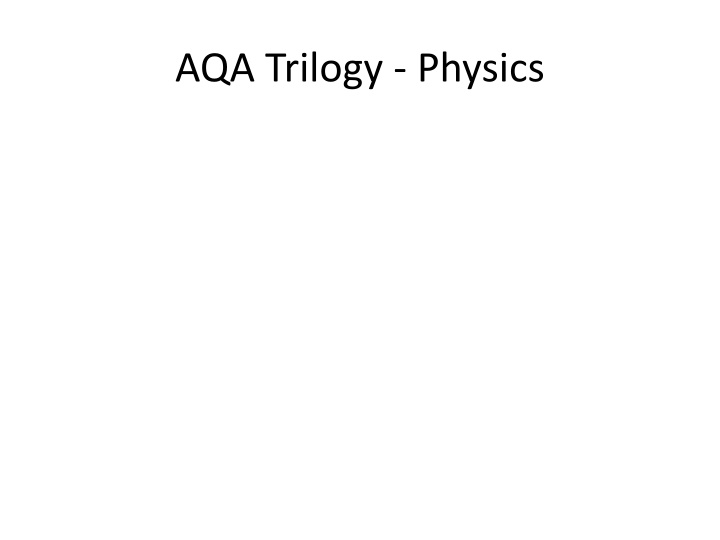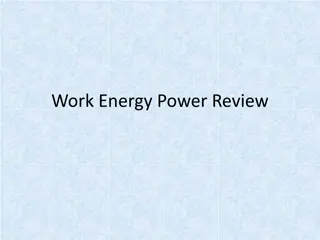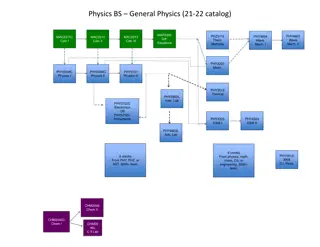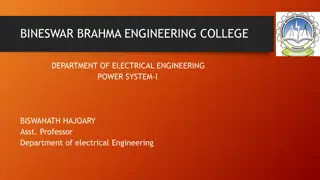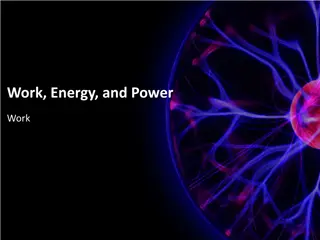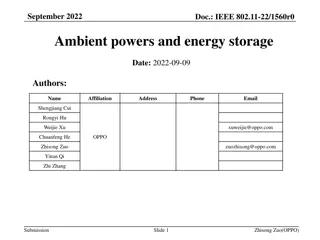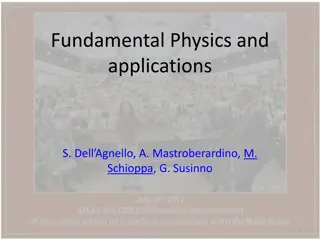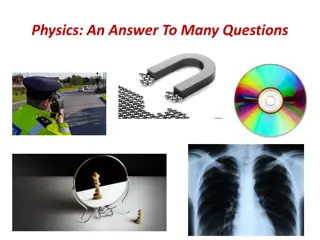Energy and Power in Physics
Explore concepts like kinetic energy, gravitational potential energy, work done, and power in physics. Learn about energy transfers, conservation laws, efficiency calculations, and environmental impacts. Understand thermal conductivity, energy efficiency, renewable and non-renewable resources, and more.
Download Presentation

Please find below an Image/Link to download the presentation.
The content on the website is provided AS IS for your information and personal use only. It may not be sold, licensed, or shared on other websites without obtaining consent from the author.If you encounter any issues during the download, it is possible that the publisher has removed the file from their server.
You are allowed to download the files provided on this website for personal or commercial use, subject to the condition that they are used lawfully. All files are the property of their respective owners.
The content on the website is provided AS IS for your information and personal use only. It may not be sold, licensed, or shared on other websites without obtaining consent from the author.
E N D
Presentation Transcript
An object with a mass of 5kg is dropped from a height of 10m, work out the speed with which it hits the ground Calculate the kinetic energy of an object with mass of 50kg and is moving at a speed of 10m/s Write the equation for calculating kinetic energy P1 Energy AQA Trilogy (GPE = KE) What does each letter stand for? Describe the energy transfers: Bringing water to a boil in an electric kettle Work out the GPE of an object that has a mass of 2kg lifted though a height of 1.5m with a gravitational field strength of 9.8N/kg Write the equation used to working out GPE (gravitational potential energy) The 8 energy stores An object being propelled upwards A car braking What does each letter stand for? Write the equation for calculating work done Calculate the work done when a force of 10N moves an object 2m Calculate the energy stored in a spring when it is extended by 6cm. The spring has a constant of 150N/m Write the equation for working out elastic potential What does each letter stand for? Check your units! What does each letter stand for? Write the two equations for working out power Machine A lifts a load of 100N through a height of 4m in 10s Machine B lifts a load of 150N through a height of 3m in 15s Which has more power? RPA 14: Determining SHC Calculate the energy change when a hot water bottle containing 1kg of water cools from 80 C to 30 C ( the SHC of water is 4200J/kg C) Write the equation for calculating the change in thermal energy What does each letter stand for? Show your workings What does each letter stand for?
Describe conduction Describe convection List how energy resources can be used P1 Energy AQA Trilogy What is meant by thermal conductivity? Define the term Watt Write the 2 equations for calculating energy efficiency What is a renewable energy resource? What is a non-renewable energy resource? Calculate the energy transfer if a 60W lightbulb is on for 100s Can you name 7? Name 3: Describe the law of conservation in a closed system A motor in a remote controlled car transfers 300J of energy to the cars energy stores. 225J are transferred to the cars kinetic energy stores. Calculate the efficiency of the motor Describe how global warming occurs Give examples of other environmental problems associated with using non- renewable fuels Describe how acid rain forms Describe ways of reducing unwanted energy transfers A blender is 70% efficient. If has a total input power of 600W. Calculate the useful power output Describe ways to increase the efficiency of an energy transfer Give examples of ways you can insulate your house
Write the equation for calculating charge flow A battery charger passes a current of 2.0 A through a cell over a period of 2.5 hours. How much charge is transferred to the cell? RPA 15: Resistance How does increasing a length of wire affect the resistance in a circuit? P2 Electricity AQA Trilogy What do the letters stand for? Draw the symbols for the following: Write the equation for calculating potential difference A 4 resistor in a circuit has a potential difference of 6.0V across it. What is the current through the resistor? RPA 15: Resistance Describe the difference between resistance in a series and parallel circuit. Lamp Voltmeter Ammeter Fuse Diode LED What do the letters stand for? You ll need to rearrange the equation Draw the symbols for the following: How does the resistance of a thermistor change as temperature increases? How does the resistance of an LDR change as light intensity increases? RPA 16: I-V characteristics Describe the resistance through an ohmic conductor Resistor Give a use of a thermistor Give a use of an LDR Variable resistor Thermistor LDR Define the term electric current Draw a series circuit diagram that consists of 2 cells and a lamp and show the set up to measure current going through the circuit and voltage across the lamp RPA 16: I-V characteristics Describe the resistance through a diode RPA 16: I-V characteristics Describe the resistance through a filament lamp
For components connected in series: The current through each component is the _________ For components connected in parallel: The total current through the whole circuit is the _______ of the currents through the separate components A 600W microwave I used for minutes. How long would a 750W microwave take to do the same amount of work? P2 Electricity AQA Trilogy The total potential difference of the power supply is ___________ between the components The potential difference across each component is the ________ The total resistance of two components is the _______ of each component Rtotal= R1+ R2 The total resistance of two components is _______ than the resistance of the smallest individual resistor Energy transfer (J) = Power (W) x time (s) Draw a parallel circuit with 2 cells and 3 lamps that can be switched on and off independently Series circuit Parallel circuit The motor in an electric toothbrush is attached to a 3 V battery. 140 C of charge passes through the circuit as it is used. Calculate the energy transferred. Energy transferred (J) = Charge flow (Q) x pd (V) Two 12V cells are connected in series with three resistors. 2 , 5 and 7 . Calculate the current through the circuit. Write the two equations to work out power Why is the national grid an efficient way to transfer energy? For the circuit diagram, calculate the current passing through the circuit. Mains electricity Is it ac or dc? Write the colour and function of the wires below: Label the diagram of a 3 pin plug Describe the role of: Step up transformers What is the frequency? Live wire What is the voltage? Neutral wire Step down transformers Describe the difference between ac and dc Earth wire
Write the equation used to calculate density A cube has edges of length 1.5cm and an average density of 3500kg/m2 What is its mass? RPA 17: Density Describe how to find the density of an irregularly shaped object P3 Particle model AQA Trilogy Check your units! Draw particle diagrams for: Describe how mass is conserved as a substance changes state from solid liquid gas Write the equation for working out change in thermal energy Calculate the change in thermal energy when 2kg of water is heated from 20oC to 80oC solid liquid gas Define the terms: internal energy Explain why changing the temperature of a fixed volume of gas, changes the pressure. Write the equation for working out energy for a changing state The specific latent heat of vaporisation for water (boiling) is 2260000 J/kg. How much energy is needed to completely boil 1.50kg of water at 100oC Specific heat capacity Specific latent heat Describe the heating graph Describe the cooling graph Explain why there are flat parts on the heating and cooling graphs Describe the movement of particles in a gas Pressure and volume are inversely proportional. That means that at volume goes up pressure goes ____________
Describe the difference between the plum pudding and the nuclear model of an atom What is an isotope? Describe Alpha decay and complete the nuclear equation P4 Atomic structure AQA Trilogy What is the approximate radius of an atom? Where in an atom are the neutrons and proton? The number of protons = the number of_________ Atomic number is the number of _________ Mass number is the number of ________ + the number of _________ Isotopes have a different number of ____________ Describe the following (include: penetration, range and ionising power) Alpha particle ( ) Describe Beta decay and complete the nuclear equation What is the approximate size of a nucleus? Beta particle ( ) Gamma ray ( ) Explain what was doing out from the alpha scattering experiment Define the term half-life Define the terms: Contamination Give the unit for activity Number of protons = Irradation Number of neutrons = What is the function of a Geiger-Muller tube? Number of electrons = Background radiation How did Niels Bohr adapt the nuclear model of the atom? Graph showing half life The activity of a sample is 640 Bq. Calculate the final activity after two half-lives.
Physics equations to learn AQA Trilogy P1-4 Power = energy transferred time P = E t Power = (current)2 x resistance P = I2 R Weight = mass x gravitational field strength W= mg Power = work done time P = W t Charge flow = current x time Q = I t Work done = force x distance W = Fs Energy transferred = power x time E = P t Potential difference = current x resistance V = I R Energy transferred = charge flow x potential difference E = Q V Kinetic energy = 0.5 x mass x (speed)2 Ek = mv2 Efficiency = useful output energy transfer total input energy transfer Density = mass volume P = m v Gravitational potential energy = mass x gravitational field strength x height Ep = m g h Power = potential difference x current P = VI Efficiency = useful power output total power input
